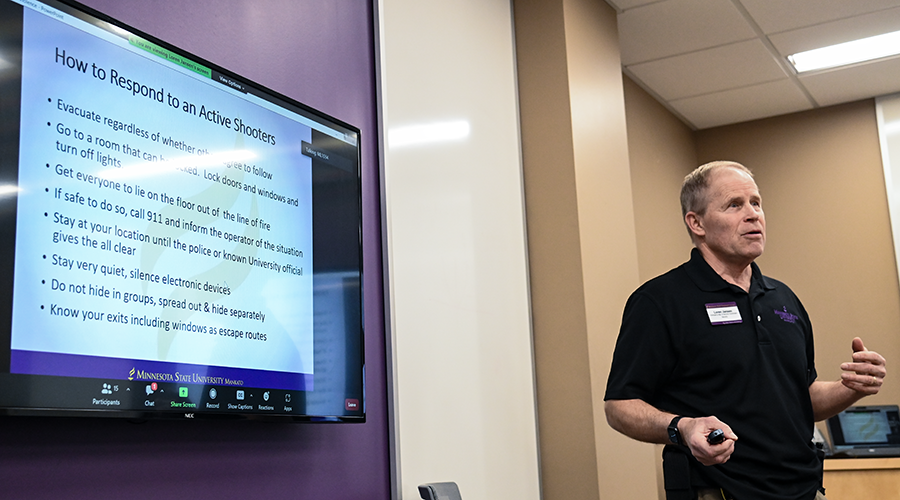Know where to hide. Lie low. And, if you have to, don’t fight fair.
We’ve all heard the words: “We never thought it would happen here.” One could expect that was said at Michigan State, University of Virginia, Virginia Tech and other college campuses tragically changed forever by an active shooter.
Statistically, college campuses have been rare targets. Generally, they are among random locations where large groups gather.
The first recorded campus mass shooting was in August 1966 in what has become known as the University of Texas tower shooting. From the tower’s vantage point, the 25-year-old shooter killed 15 people before he was killed by police.
Since then, about a dozen college shootings regarded as mass murders have occurred. Such attacks are often followed by renewed national efforts to secure campuses against random attacks of violence.
As part of its annual Disaster Awareness Week programming for staff, the Memorial Library featured a presentation on Workplace Violence by Loren Jansen, Emergency Manager and Security Coordinator with University Security.
By coincidence, the scheduled session on Feb. 14 occurred the day after the Michigan State shooting.
With half of his programming addressing active shooters, Jansen shared the FBI’s Run, Hide, Fight video and other advice for surviving a mass shooting incident.
From FBI and Secret Service statistics, Jansen said college campus shootings, to date, account for just over 5 percent of all mass shootings. The findings show 96 percent of shooters are male. Of those attackers, 53 percent were not affiliated with the attack site and 68 percent attacked random targets.
“Just like this Michigan State incident, no connection (between the shooter and the university). It’s just random,” Jansen said. “It’s a place to go to. It’s a place where people are at, whether it’s the mall, the church or the school.”
Shared information, tips and tactics for surviving an active shooter incident included:
CAMPUS SECURITY
- Minnesota State Mankato has about 200 HD-quality cameras across campus. In the case of an emergency, security can override card access to exterior doors on several buildings on campus.
- With 911 calls that involve criminal activity or violent behavior, police and other law enforcement officers are dispatched. Campus security is then contacted and assists, as needed, after the incident is contained.
- The University’s STAR ALERT texting system is very effective in quick notification of the campus community when emergency situations occur. In the case of an active shooter, individuals should remain sheltered in place until notified through STAR ALERT or police instruction.
- Notify Campus Security of any suspicious behavior on campus. Jansen said if nothing comes of it, there will at least be a written report of the incident that may assist future calls or incidents.
IN CASE OF AN ACTIVE SHOOTER INCIDENT
HAVE A PLAN
- Most shootings are over within 5 minutes, generally well before police arrive. It may not be on one’s mind, but having a plan in the case of an active shooter could be the difference between victim or survivor.
- “You need a plan. If your plan is to call 911, I’m telling you, you need a better plan,” Jansen said. “What we are looking at is a mindset of awareness, preparation and rehearsal.”
- Jansen said rehearsal means knowing your exit points; determining which doors have locks or which rooms make good hiding spots. “You have a plan, so if it happens you don’t just stand there like sheep and your just helpless. You have to act and you have to move.”
- Know that responding law enforcement will not attend to injured victims. Their first responsibility is to contain and halt the attack. Emergency medical responders will not enter or be allowed into a crime scene until it is safe to do so.
RUN
- Get away from the area if possible.
- Don’t wait for others, if they don’t want to move
- If you come upon law enforcement, raise and show your hands.
HIDE
- If you cannot reach an exit when fleeing an active shooter incident, find a room. One with a lock is preferred, however, most classrooms on campus do not have locks. Barricade the door when possible and turn out the lights.
- Stay quiet. Silence your phone and all electronic devices.
- Lie flat where possible. Fired rounds can pierce walls. You do not want to be standing if somebody is shooting a lot of rounds.
- A backpack filled with books can serve as a makeshift bulletproof vest. Jansen said a fired round could go through a few layers, but it can slow down a bullet.
FIGHT
- In extreme circumstances, fight. If you’re part of a group, there is strength in numbers.
- If a shooter is able to enter a room, stay to the sides of the door. The first reaction for someone entering a room is typically to look straight ahead. Be ready to strike as soon as you can and before the shooter has time to adjust.
- Don’t fight fair. Use anything available: a fire extinguisher, a closet rod, a table leg, scissors, a pen or pencil to the eye. Target the eyes, throat, head or groin. “Do anything that works. This is all about survival. It’s all about walking away at the end of the day,” Jansen said.
- Work as a group, neutralize the threat and restrain the shooter until help can arrive.

